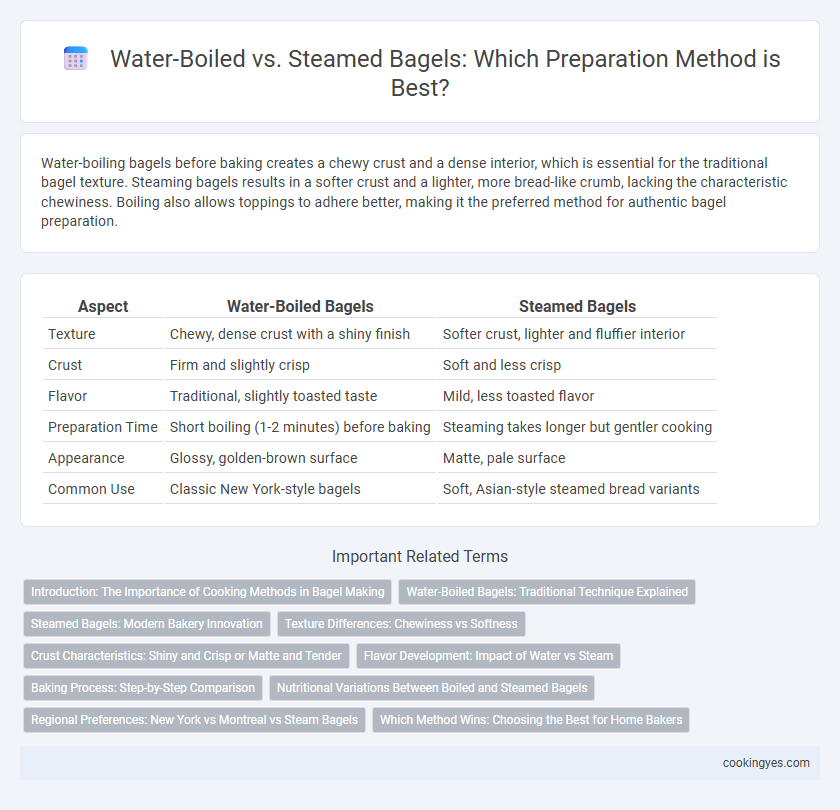Water-boiling bagels before baking creates a chewy crust and a dense interior, which is essential for the traditional bagel texture. Steaming bagels results in a softer crust and a lighter, more bread-like crumb, lacking the characteristic chewiness. Boiling also allows toppings to adhere better, making it the preferred method for authentic bagel preparation.
Table of Comparison
| Aspect | Water-Boiled Bagels | Steamed Bagels |
|---|---|---|
| Texture | Chewy, dense crust with a shiny finish | Softer crust, lighter and fluffier interior |
| Crust | Firm and slightly crisp | Soft and less crisp |
| Flavor | Traditional, slightly toasted taste | Mild, less toasted flavor |
| Preparation Time | Short boiling (1-2 minutes) before baking | Steaming takes longer but gentler cooking |
| Appearance | Glossy, golden-brown surface | Matte, pale surface |
| Common Use | Classic New York-style bagels | Soft, Asian-style steamed bread variants |
Introduction: The Importance of Cooking Methods in Bagel Making
Water-boiling and steaming are critical techniques that significantly impact bagel texture and flavor. Boiling creates a dense, chewy crust by gelatinizing the starches, while steaming produces a softer, less chewy surface with a lighter crumb. Choosing the right method influences the traditional bagel's characteristic bite and shelf life.
Water-Boiled Bagels: Traditional Technique Explained
Water-boiled bagels undergo a brief boiling process before baking, which creates a dense, chewy texture and a glossy, golden crust that distinguishes them from steamed bagels. This traditional technique gelatinizes the starch on the bagel's surface, ensuring a crisp exterior while maintaining a moist, tender interior. The boiling water solution often includes malt syrup or baking soda to enhance flavor and promote browning during the subsequent baking phase.
Steamed Bagels: Modern Bakery Innovation
Steamed bagels represent a modern bakery innovation, offering a softer crust and lighter texture compared to traditional water-boiled bagels. This steaming method preserves moisture within the dough, resulting in a chewier interior and reducing the risk of overcooking. Many artisanal bakeries incorporate steam techniques to create unique variations that appeal to contemporary tastes while maintaining the bagel's classic essence.
Texture Differences: Chewiness vs Softness
Water-boiled bagels develop a dense, chewy crust due to the gelatinization of starches on the surface during boiling, which locks in moisture and creates a signature firmness. Steamed bagels tend to have a softer, more tender exterior since steaming cooks the dough without forming a crust, resulting in a fluffier texture overall. The choice between boiling and steaming directly influences the bagel's chewiness versus softness, impacting its mouthfeel and traditional authenticity.
Crust Characteristics: Shiny and Crisp or Matte and Tender
Water-boiled bagels develop a shiny and crisp crust due to the gelatinization of starches on the surface, creating a firm outer layer that enhances texture and bite. In contrast, steamed bagels result in a matte and tender crust, as the moist heat softens the dough without forming a hard shell. The choice between boiling and steaming significantly impacts the bagel's characteristic crust, influencing both appearance and mouthfeel.
Flavor Development: Impact of Water vs Steam
Boiling bagels in water triggers the Maillard reaction more effectively, creating a distinctive chewy crust and deep, complex flavors due to caramelization. Steaming produces a softer surface with a lighter crust, resulting in a milder taste and less pronounced browning. The water-boiled method enhances flavor development by promoting crust formation and richer caramel notes essential to traditional bagels.
Baking Process: Step-by-Step Comparison
Water-boiling bagels involves immersing dough in hot water for 30-60 seconds, creating a chewy crust by gelatinizing the starches before baking, whereas steaming introduces moisture but lacks the gelatinization effect, resulting in a softer, less chewy texture. During baking, water-boiled bagels develop a dense interior and glossy, firm crust due to the pre-baking water bath, while steamed bagels often feature a lighter crumb and matte surface. The choice between water-boiling and steaming critically influences the final bagel's texture and appearance through these distinct biochemical reactions.
Nutritional Variations Between Boiled and Steamed Bagels
Water-boiled bagels retain more moisture and have a denser texture due to starch gelatinization during boiling, which also reduces sugar content by leaching sugars into the water. Steamed bagels generally have a lighter, softer crumb but contain higher sugar levels and fewer minerals compared to boiled bagels, as steaming lacks the leaching process. The boiling method enhances nutrient retention like B vitamins and minerals, while steaming may preserve more surface nutrients without altering internal composition significantly.
Regional Preferences: New York vs Montreal vs Steam Bagels
New York bagels are traditionally water-boiled, creating a dense, chewy texture with a glossy crust favored in the Northeast United States. Montreal bagels are boiled in honey-sweetened water before baking, producing a slightly sweeter and thinner bagel with a crispier exterior popular in Quebec. Steam bagels, less common in these regions, use steam during baking to achieve a softer, less dense crumb, attracting those preferring a fluffier texture over the classic chewiness.
Which Method Wins: Choosing the Best for Home Bakers
Water-boiled bagels develop a chewy crust and dense texture due to the starch gelatinization during boiling, which locks in moisture and enhances flavor development. Steamed bagels result in a softer, less chewy exterior with a lighter crumb, appealing to those who prefer a tender bite but lack the traditional chewiness. For home bakers seeking the authentic New York-style bagel with a distinct crust and dense bite, the water-boiling method remains the superior choice.
Water-boiled vs steamed for bagel preparation Infographic

 cookingyes.com
cookingyes.com